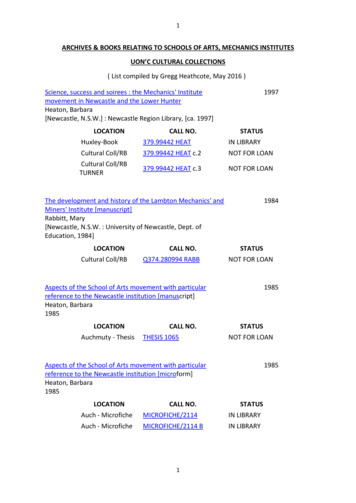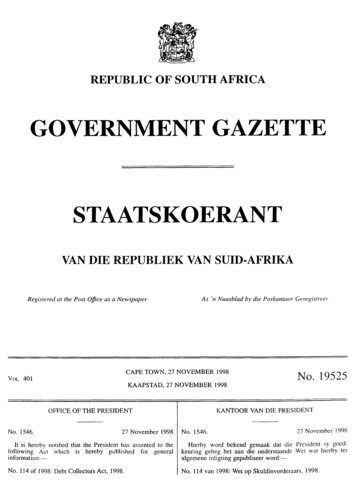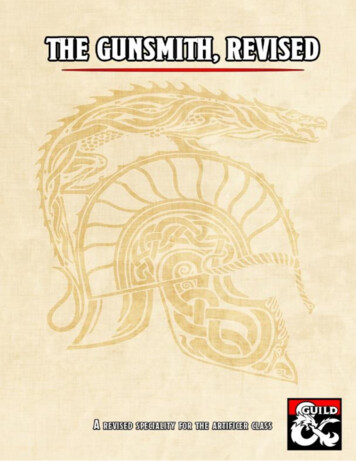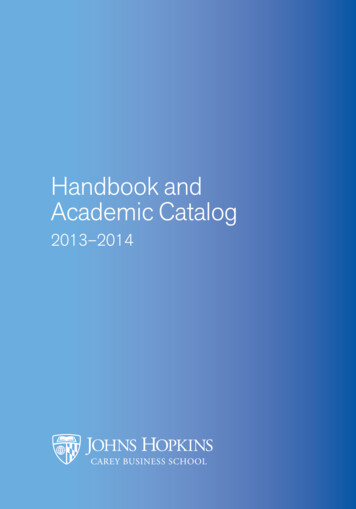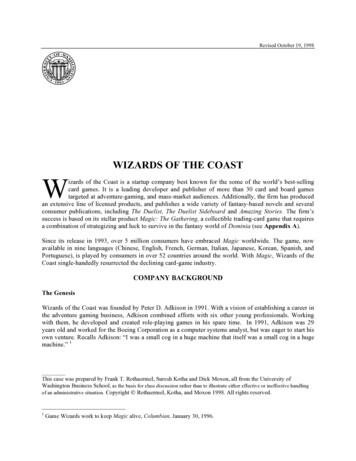
Transcription
Revised October 19, 1998WIZARDS OF THE COASTWizards of the Coast is a startup company best known for the some of the world’s best-sellingcard games. It is a leading developer and publisher of more than 30 card and board gamestargeted at adventure-gaming, and mass-market audiences. Additionally, the firm has producedan extensive line of licensed products, and publishes a wide variety of fantasy-based novels and severalconsumer publications, including The Duelist, The Duelist Sideboard and Amazing Stories. The firm’ssuccess is based on its stellar product Magic: The Gathering, a collectible trading-card game that requiresa combination of strategizing and luck to survive in the fantasy world of Dominia (see Appendix A).Since its release in 1993, over 5 million consumers have embraced Magic worldwide. The game, nowavailable in nine languages (Chinese, English, French, German, Italian, Japanese, Korean, Spanish, andPortuguese), is played by consumers in over 52 countries around the world. With Magic, Wizards of theCoast single-handedly resurrected the declining card-game industry.COMPANY BACKGROUNDThe GenesisWizards of the Coast was founded by Peter D. Adkison in 1991. With a vision of establishing a career inthe adventure gaming business, Adkison combined efforts with six other young professionals. Workingwith them, he developed and created role-playing games in his spare time. In 1991, Adkison was 29years old and worked for the Boeing Corporation as a computer systems analyst, but was eager to start hisown venture. Recalls Adkison: “I was a small cog in a huge machine that itself was a small cog in a hugemachine.” 1This case was prepared by Frank T. Rothaermel, Suresh Kotha and Dick Moxon, all from the University ofWashington Business School, as the basis for class discussion rather than to illustrate either effective or ineffective handlingof an administrative situation. Copyright Rothaermel, Kotha, and Moxon 1998. All rights reserved.1Game Wizards work to keep Magic alive, Columbian, January 30, 1996.
Wizards of the CoastAdkison has been intrigued by strategy and role-playing games ever since he was 11, when his father washis first tutor and playmate. Later in high school, he developed a long-standing passion for role-playinggames, which inspired his dream of creating fantasy-adventure games. A turning point in his life came in1991. Adkison, while surfing the Internet, met a fellow-game inventor Richard Garfield. Garfield was a27-year-old Ph.D. student in combinational mathematics at the University of Pennsylvania and was anavid game aficionado who had been designing his own games from the young age of 15. As a graduatestudent, Garfield was trying to market a board game he had designed called RoboRally. At thisserendipitous encounter over the Internet, Adkison and Garfield discussed the idea of collaborating onfantasy/adventure games.Recalls Adkison: "My idea was to combine a fantasy game concept, where players controlled the acts ofmystical characters, with a "trading-card" format, where fans could buy and sell collectible cards similarto that of their sports heroes.” Recalls Garfield: “The concept of a trading card game was one of the only‘Eureka!’ experiences I’ve had.”2 He (Garfield) too had contemplated about the creating fantasy gamessince the mid-1980s when he first played a board game named Cosmic Encounter. One of the pieces inCosmic Encounter had special powers. By invoking these powers a player could change the rules of thegame in mid-game. This intrigued Garfield. And he wondered, ‘What if all the pieces were magic, eachone altering the game in some unique way?’ He had always believed that this idea could lead to a boardgame that was truly based on fantasy.Adkison, however, persuaded Garfield not to work on a board game but instead focus on cards. Adkison’swanted to avoid the ‘elaborate’ equipment of a board game. Recalls Garfield: "The goal was to create agame that was fun and portable and that could be played under an hour.” Ultimately, Garfield's notion offantasy, and Adkison's idea of a trading-card format, formed the basis for a new card game that Garfieldinvented in three months. Adkison and Garfield called their joint invention Magic: The Gathering (seeExhibit 1).While Magic was being test marketed and readied for release, Garfield began teaching math at WhitmanCollege in Walla Walla, Washington. In August 1993, operating as an eight-person company out of thebasement of Adkison’s home, Wizards of the Coast released Magic: The Gathering. The game became anovernight success and won critical acclaim from industry observers and critics.The first trading card game of its kind in the world, it sold more than 10 million cards in just six weeks,even though the company had estimated that this first printing would last one year. Notes WayneGodfrey, CEO of War Games West: “My initial order was for 24 units, my second order was for 572, andthird was ‘send everything you’ve got in the warehouse.’”3 An immediate success, Magic establishedWizards of the Coast as a dominant player in the adventure card gaming industry.With Magic's success, Garfield quit his teaching and began to pursue his true passion as a game inventorwith the Wizards of the Coast. Adkison made Garfield an equity partner in Wizards of the Coast, andfully dedicated his then fledgling firm to creating fantasy card game. Adkison too quit his job at theBoeing Corporation to become the president and CEO of Wizards of the coast.In less than two years, Adkison has taken the firm from a basement business to a gaming corporation.According to industry analysts and observers, the firm recorded sales of about 50 million in 1994, thefirst full year that Magic was sold. This amount then doubled in 1995. For this outstanding2Kimberly Wilson, “Generation X gets its magic moment and killing’ opponents is part of the game,” Seattle PostIntelligencer, August 15, 1998.3Seanna Browder, “Zero to 50 million: Now that’s Magic,” Business Week, October 2, 1995, p. 10.2
Wizards of the Coastaccomplishment, Adkison received the 1995 Northwest Entrepreneur of Year award, an award sponsoredby the consulting firm Ernst & Young, Inc, and others.In 1998, the firm's estimated sales were greater than 100 million. It had more than 500 employees andwas located in a new 178,000-square-foot office complex down the street from Boeing Corporation’s jobcenter in Renton, Washington. It had international offices in Antwerp, London, Milan, and Paris.THE ADVENTURE GAMES INDUSTRYAccording to the Game Manufacturers Association, the term “adventure games” covers a broad spectrumof board games, miniatures games, role-playing games, card games (conventional and collectible),computer games, and play-by-mail games. According to the Game Manufacturers Association estimatesthe adventure games industry generated sales of about 750 million in 1995, an amount that representedabout 60 percent of the 1.25 billion generated by the entire game and puzzle industry (see Exhibit 2)Although there is no clear distinction between adventure and family games, what makes adventure gamesunique is the fact that people pursue these games as a serious "hobby." Players dedicate a certain amountof time, on regular basis, to pursue a certain game. The time dedicated ranged from casually playing foran hour or two a week to many hours per week. Such dedication was generally extended over a longperiod of time, often years.Many adventure games are so complex that they require a total player commitment. Perhaps this explainswhy some adventure games such as Dungeons and Dragons have a cult-like following. This dedicatedinvolvement by the players–gaming as a serious hobby–is the common denominator in defining adventuregames. Playing adventure games became an important part of a player’s life and many players were oftenaddicted or obsessed with these games. Finally, these adventure games included elements of fantasy andthe occult.According to a survey conducted by the Game Manufacturers Association adventure game enthusiastswere young, literate and did well in scholastic endeavors. The survey results indicated that a majority ofthem were very young-about 31 percent were between 10 and 14 years of age, about 37 percent werebetween 15 and 18 years old, and 32 percent were 19 years or older. The survey also revealed that about82 percent of the respondents noted that they maintained a grade-point average of 3.0 or better in highschool or college, and about 65 percent said that they read 36 or more books a year. And about 80 percentdescribed themselves as book reader (See Exhibit 3).Within the adventure games, there are many different market segments.Historical GamesOne big segment of the industry comprises of historical games such as miniature games and boardwargames.Role-Playing Fantasy GamesThis segment comprises of role-playing games such as the ‘infamous’ Dungeons and Dragons.Collectible Card GamesA third major segment comprises of collectible card games – like Magic: The Gathering.3
Wizards of the CoastMost adventure games are sold through independent or franchised game, comic, or hobby shops. Somepopular games that have a large following such as Magic are also sold in national chain toy stores, such asToys-R-Us, and in bookstores such as Barnes & Noble.STRATEGY OF WIZARDS OF THE COASTAdkison also believes strongly in the intellectual and educational value of Wizards’ games. They are “amental analog to sports,” stretching the mind in the same way that athletics stretch the body.4 NotesAdkison, I wouldn't mind being a 500 million to 1 billion company. We want to make games as big asthe movies. Garfield, the inventor of Magic sees adventure games as the “intellectual counterpart of sports– they keep you mentally fit.” He also believes that with playing Magic comes “a lot of stealtheducation,” whether it’s art appreciation because of the beautiful cards or enhanced literacy because of theoccasional quote from Shakespeare on the Magic cards.5 Garfield also believed that Magic was a strategicgame that can only be played successfully when the player had a good understanding of strategy,probability, and chance.Product StrategyMagic’s success has enchanted the adventure games industry since the famous game has virtuallyconjured the card-trading industry over night. According to Matt Mariani, managing director at DecipherInc., a Norfolk, Va., company that bought Start Trek and Star Wars collectible card games once Wizardsestablished the field: "Magic has really changed the way people play games. The serious game playersare taking to this Magic game like I’ve never seen before. It’s amazing. It’s just wonderful.”Magic cards are sold in “starter decks” of 60 randomly selected cards for about 8.95, and “boosterpacks” of 8 or 15 cards for about 2.95 retail price. Even though these are the recommended retail pricesby Wizard of the Coast, it is not uncommon for retailers to mark up the prices of highly demanded cards.Some stores even unbundled the decks and sold the cards individually. The price of each card isdetermined by its strategic role in the game and its collector value. Important to note is that each “starter”and “booster” deck is unique, so no one starts out with an identical deck. Therefore, players buy “boosterdecks” or individual cards or trade cards–often via the Internet–to enhance their individualized starterdeck.The cards feature beautiful, original artwork that appeals to fantasy game players and collectors alike. Asa consequence of this, Magic cards are both collected and traded–some for their strength, some for theirscarcity, some for their beautiful artwork. A noted example of a highly desired card is the Black Lotus, ofwhich only 1,100 copies were printed out of the approximately 3 billion cards printed in total (seeExhibit 4). The Black Lotus is so powerful that it has been banned for some of the professionaltournaments organized by Wizard of the Coast. The quotes for the ‘black market’ price for the BlackLotus ranges from about 150 to more than 1,000.6The game itself has won several prestigious awards, including the “Top Five Mind Games” award fromMensa, the high-IQ club, Game of the Year from the Italian Gaming Society in Rome and a “Good asGold” award at the International Game Festival in Cannes, France.74Warren Wilson, “Creating Magic Renton game company is dealt a winner, and keeps dreaming,” Seattle PostIntelligencer, March 11, 1996.5George Tibbits, “Game company prospering despite early missteps,” Seattle Times, February 7, 1996.6Business Week, October 2, 1995, p. 10.7Seattle Post Intelligencer, March 11, 1996.4
Wizards of the CoastTarget SegmentGeorge Skaff Elias, the 27 year-old chief developer for Wizards of the Coast, describes the typical Magicplayer as person with a college degree, a high household income and an affinity for computers.8 The gamewas very popular with young males in their teens or twenties. However, the game had also caught onwith younger teens, and older men and women as well. Nevertheless, what draws mostly malecompetitors was the American pursuit of baseball card trading.Magic’s would be wizards were first encountered in public in specialty game stores like Games andGizmos. However, today it is not unusual to find players in coffeehouses like Starbucks or on universitycampuses. In particular, dormitories have been a breeding ground for new wizards. Notes MichaelPeterson, a 19-year old sophomore at Seattle University, which even has its own Magic club: “I’ve triedsome of the other games, but for me Magic is where it’s at. It’s such a wonderful game because it makesyou think. It’s a strategic game. It’s going to be the next chess. I’m a history and political science major,and someday I’ll probably go on to be a lawyer, but after I’m the world champion of Magic.”9 Peterson, atypically Magic wizard, says that he spent anywhere between 10 and 30 hours a week on the game andabout 20 a months acquiring ‘new’ cards.A more atypical Magic fan was toy analyst David Liebowitz of Burnham Securities Co. in New YorkCity:It’s fair to say I’m hooked. I either have too many cards or not enough. I’m not quite sure yet. Given theirsuccess to date, their opportunities looking forward appear to be promising. If they continue on the currentgrowth trajectory, I would be surprised if investment bankers weren’t knocking on their doors to take it public.10The frenzy that Magic has spelled upon some of the youths has sparked even some criminal acts. Forexample, a trio of gamers was mugged by some street toughs at knifepoint for their collection of Magiccards valued at about 2,400. Due to short supply, some riots have also been reported in Japan.Marketing, Operations, and DistributionMarketing?Wizards of the Coast has built a widespread retail network to market its cards. Not only are Magic cardssold directly in Wizard’s retail and gaming stores but also in more than 10,000 book, record and comicbook stores including Barnes & Noble, Tower Records, Software Etc., Borders Books.11 About some 75percent of Magic cards and related products are sold through hobby and game stores, the remaining 25percent are sold through chain and independent bookstores.12 Some local retailers organize weekly Magiccompetitions to lure potential customers in their store.Operations management has also been a challenge for Wizards. Due to its tremendous growth in a veryshort time, manufacturing of the Magic cards has been a constant bottleneck. In the beginning, Wizardsof the Coast relied only on one supplier: Carta Mundi in Belgium, since no other firm could deliver thequality needed in combination with the required sophisticated sorting of the Magic cards. In the8Bernhard Warner, “The ‘Gathering’ storm,” Brandweek, February 17, 1997.Seattle Post Intelligencer, March 11, 1996.10M. Sharon Baker, “Wizards of the Coast seeks to extend Magic’s power spell,” Puget Sound Business Journal,January 27, 1995.11Brandweek, February 17, 1997.12Karen Angel, “Harper titles with a Magic touch,” Publishers Weekly, February 3, 1997.95
Wizards of the Coastmeanwhile, Wizards has extended the number of suppliers to include firms such as Quebecor, SherphardPoorman, USPC, and Yaquinto. Nevertheless, Carta Mundi is still Wizards’ largest print supplier.Philosophy, Culture and Human ResourcesAdkison, on the one hand he is attempting to build the corporate capabilities necessary to develop thebusinesses to its full potential, and on other he leads by example since he refuses to have his own office oreven a cubicle. On his business cards and memos, his position and title is ‘CEO and janitor’ of Wizardsof the Coast.13 Adkison notes that he is striving to retain a casual, creative atmosphere that toleratesindividualism and creativity, expressed for example in eccentric clothing, body piercing, and frequent nerfwars among employees.Even though Wizards has experienced tremendous overnight success, it has also experienced manysetbacks including drastic reorganization, layoffs, and tough negotiations with artists. “I’ve made somany mistakes, it’s not even funny,” Adkison says. Adkison’s challenges on managing human resourcesfor Wizards is indicated by his statement that he wouldn’t call his current position work but ratherdescribes it as “counseling, herding cats.”14Notes Adkison: “There’s nobody in the company who’s ever managed a company this size, including me. We’re trying to balance the desire for top-notch people to take us to the next level, and the desire tostay true to people who founded the company.”15To meet this challenge, the firm has hired experience managers as well as consultants, changed thecomposition of its board of directors, provided training and established mentoring relationships. Pointsout Adkison:None of the people who reported to me in 1993 report to me now. Many of them are still here, but experiencedmanagers have come into the organization between them and myself. Our board of directors has evolved also,going from a board composed mainly of founders and management to a board with five outside directors whohave a lot of gray hair.16Adkison himself completed an MBA degree at the University of Washington Business School to enhancehis management skills. In 1996, Wizards hired Richard Fukutaki to be the vice president and manager forMagic: The Gathering. Fukutaki brings excellent industry experience with him, since was vice presidentof boys marketing, entertainment and licensing for Tyco and senior product manager for Mattel Toys (seeExhibit 5 for a partial listing of the firms top management).Extensions Through LicensingWith Magic achieving a cult status, Adkison is now actively attempting to leverage the firm's brand namethrough licensing into to book series, computer games, and possible movie and television deals. “Rightnow, we’re putting together a strategy for licensing,” says Adkison, “we’re in a good position of beingable to pick and choose.”17.In total, he has entered into eight licensing agreement over the last three years. For example, Magicappears as a book series by HarperCollins, in two CD-ROMs computer games, one by MicroProse and13Seattle Post Intelligencer, March 11, 1996.Ibid.15Puget Sound Business Journal, January 27, 1995.16Written interview of Peter Adkison, CEO of Wizards of the Coast, by Jenne Pierce, May 29, 1997.17Puget Sound Business Journal, January 27, 1995.146
Wizards of the Coastthe other by Acclaim Entertainment, and in comic books, also by Acclaim Entertainment. HarperCollinshas published 12 paperback science fiction and fantasy novels under the licensing agreement, with morethan a cumulative 500,000 copies sold. The best seller book in this series, ‘Arena’ by William R.Forstchen, has sold alone 300,000 copies.Wizards is discussing collaborations with other publishers. Wizards spokeswoman Sue-Lane Woodexplains that bookstores are a logical market for Wizards’ products, “Magic players are heavy readerswho really appreciate the fantasy genre, and Magic itself is often played in bookstores. Our secondaryproducts support the game but can be appreciated by players and non-players alike.”18In addition, Magic merchandise has been extended through licensing into prepaid phone cards (MCI),clothing (Nice Men), card albums and protectors (Rembrandt), strategy guide and encyclopedia(Thounder’s Mouth Press and Carlton Books), and calendars (Workman).19 Wizards has just recentlyreached an agreement with Saltmine Creative, a Web development and design company based in Seattleand London to develop interactive CD-ROM products, such as encyclopedias which will serve as guide tothe fantasy worlds created by Wizards. Wizards also have received movie and television offers, however,they are still looking for the right fit. Licensing revenues are estimated to be around 1 million annually.In the summer of 1997, Wizards has introduced a more mainstream version of Magic named Portal. Thegame was targeted at a broader audience such as younger teens and families. It was introduced with a 45 million, national media marketing blitz. Notes Charlotte Skeel, senior director of marketing at Wizardsof the Coast: “This is the first opportunity to create a national message. We want to appeal to a broaderaudience that wouldn’t be necessarily considered core gamers.”20Creating LegitimacyTo increase sales the firm is attempting to professionalize the activity of playing Magic. Notes Adkison:"The idea is to transform Magic into a legitimized sport. It’s been proven that sports are very sustainable.They hold people’s attention for a long time.”21The company is trying to create players with celebrity standing who will then positively influence thegames’ popularity in the mass market. In 1996, for instance, the Wizards has organized a six-cityprofessional tournament series that offers 1 million in prices and scholarships. Many semi-professionaltournaments were also held. In total, there are more than 1,000 tournaments a week worldwide, many ofthem held in Wizards’ retail stores.Wizards has also created a computer-based, global ranking for all professional players like the one used inchess or tennis. Every player can access the world ranking of best players on the Wizards of the Coasthomepage (www.wizards.com) (see Exhibit 6). The 1998 World Championship has generated such atremendous interest, that even ESPN2 recorded the event. Players from 45 countries competed for theworld championship title. Overall, some 50,000-tournament players competed in 30 leagues within theUS.It pays to be a celebrity in the Magic circus. The 1998 World Champion, Brian Selden walked away with 34,000 in prize money for winning the tournament, which was held at the Wizards of the Coast gamingcenter in Seattle’s University District. The US team won the team competition and walked away with18Publishers Weekly, February 3, 1997, p. 31.Brandweek, February 17, 1997.20Karen Benezra, “Wizards conjure 4-5M gameplan,” Brandweek, June 23, 1997.21Adam Worcester, “Wizards aims to repeat Magic success,” Puget Sound Business Journal, June 26, 1998.197
Wizards of the Coast 22,000. The entire event was endowed with 250,000 in prize money. The entire Pro-tour was endowedwith more than 1 million in prize money. Another star player, Matt Place, a college dropout fromKansas City, Mo., has won more than 55,000 at professional meetings around the world since 1996.SponsorshipsTo cover the 1998 world championship event, Wizards of the Coast attracted a corporate sponsor: MCITelecommunications. According to a report in Brandweek:Corporate tie-ins are mutually beneficial: the small start-up company is ‘legitimized’ by a renowned corporatepartner, through which it is able to gain access to a mainstream audience and acceptance, and, on the otherhand, the renowned corporate partner is searching for demographic synergies and “cool-by-association imagethat come with linking to the Next Big Thing.”22MCI bets on those synergies when partnering with Wizards since it recognized the potential in courtingthe core market of prepaid telephone cards: the college-aged crowd. In particular, MCI has agreed tosponsor Wizard’s Magic US tournaments in exchange for exclusive worldwide rights to produce anddistribute Magic prepaid telephone cards featuring. The number 2 telecommunications company paid anestimated 750,000 for the three year contract.The MCI prepaid Magic telephone cards featuring original artwork of Magic cards, including such highlydesired cards like the ‘Black Lotus’ and other creatures of Dominia’s population. In addition, the MCIMagic prepaid telephone card features a hotline where Magic players can receive up-to-the minutetournament information, including tour dates, individual player rankings and game strategy. The MCIprepaid Magic cards are themselves collected and traded.MCI’s goal is it to establish a loyal clientele in the college-age crowd. Points out Seth Matlins, vicepresident of corporate consulting at ProServ, the Arlington, Va., sports and event marketing agency thatbrokered the deal: “First and foremost [there’s the] passion of Magic players. The Magic player wantseverything Magic and collects everything Magic. You’ve never seen core use loyalty like this. It’sunrivaled across any other product or service category."23Another approach that Wizards of the Coast utilizes to extent the longevity of its Magic game is amagazine called The Duelist. This magazine includes all the information a serious player needs withregard to important upcoming tournaments. In addition, the player can study insider tips on how toimprove his game strategy given by celebrity players such as Zak Dolan, the Magic World Champion of1994.Retailing and International ExpansionIn May 1997, Wizards of the Coast opened its first retail and gaming store, a 32,000-square-feet Wizardsof the Coast Game Center located in Seattle’s University District close to the campus of University ofWashington (see Exhibit 7). Designed as the first authentic gaming environment and entertainment centersolely dedicated for adventure gamers, the center is also the game-testing site for top game manufacturerssuch as Atari and Williams/Bally. It is also the official tournament location for the Magic World’sChampionships and other amateur and professional organized game play. Notes Adkison:2223Bernhard Warner, “The ‘Gathering’ storm,” Brandweek, February 17, 1997.Ibid.8
Wizards of the CoastThe game is just one piece of the puzzle. We’re building stuff around the game – a back story, tournaments,leagues – and creating stars that all add to the game. Magic with all the organized events is becoming muchmore like a sport. The game center is sort of like NikeTown or Planet Hollywood. We have the opportunityto create the ultimate atmosphere. This is a club, a hangout, a place for a game player to go and know they canplay any time. We believe that the biggest opportunity for growth is to improve the retail aspect.The game is played worldwide in 65 countries by more than 5 million players. The company now hasinternational offices in Antwerp, London, Milan, and Paris. Adkison indicates that the company plans toopen an office in China in 1998, and that an office in Japan will soon become reality too.24AcquisitionsWizards of the Coast has currently completed two major acquisitions in 1997. Five Rings Publishing,best known for the Legends of the Five Rings trading card game, and TSR Inc., creators of the Dungeonsand Dragons adventure game, are now fully owned subsidiaries of Wizards of the Coast. To fullyintegrate these acquisitions has been a major challenge for Wizards. For example, TSR was at least sixmonths behind its royalty payments to authors, and it had also about 13 million outstanding claimsagainst it from its suppliers. Wizards indicated to fully satisfy those claims. TSR’s Wisconsin officeswill be phase out, however, Wizards has offered new jobs in Renton to 70 TSR employees out of TSR’stotal staff of 85. However, Wizards expects to retain the TSR name.There are indications that Wizards of the Coast might continue a growth strategy through acquisitions.For example, the firm raised 30 million in private debt in the spring of 1998. The firm hopes to use thismoney to acquire companies other gaming firms. Rumors suggest that the firm may be interested inacquiring Westend Games, a Pennsylvania company that owns two lucrative licenses, one for Star Warsrole playing system, and the other for DC Comics role playing game.25CHALLENGES FACING WIZARDS OF THE COASTAdkison recognizes that Wizards of the Coast still remains a one-product company whose future is tightlylinked to the success of Magic. Notes Adkison: "Magic provides 90-something percent of our cash flow.It is obviously our primary focus. The big strategic issue with Magic is to develop its potential to becomea ‘classic game’ that yields steady profits year after year."Currently this and other concerns required his immediate attention. First, given that numerous competitorsare trying to emulate this approach, Adkison was concerned about finding ways to sustain the success ofMagic as well offer new products. Secondly, he concerned about managing growth domestically andinternationally, as he continued to open retail operations and looked to enter new countries. Finally, hewas concerned about how to maintain the free-spirited culture and creativity prevalent at Wizards of theCoast, while at the same time finding ways to reconfigure the royalty payments made to many the firm'simportant artists.Sustaining the MagicIn 1995, Jim Stanton, who overseas Magic’s development for Wizards of the Coast, estimated that therewere about 40 trading card games competing with Magic and that it was only a matter of time before evenmore would pop up.26 Other estimates speak of up to 100 competitors and imitators.27 This is no wondersince the entry barriers into the adven
own venture. Recalls Adkison: “I was a small cog in a huge machine that itself was a small cog in a huge machine.” 1 _ This case was prepared by Frank T. Rothaermel, Suresh Kotha and Dick Moxon, all from the University of Washington Business School,


